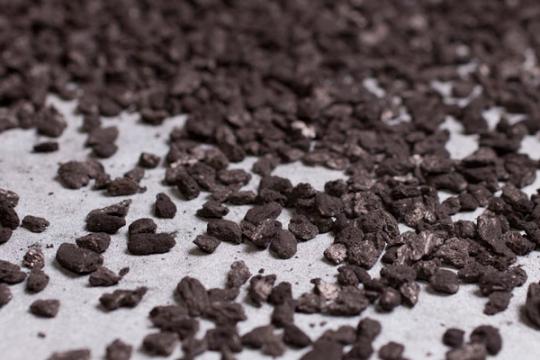How does active carbon work?
Active carbon removes contaminates using two processes:
Adsorption (Van der Waals force):
Contaminates are attracted by this force into the pores of the active carbon where they stay attached to the walls. The process depends on:
- the type of source material of the active carbon to determine the size of the pores and thus the contaminate type and removal level
- the chemical nature of the source material
- the chemical composition and concentration of the contaminant
- the temperature and PH of the water
- the contact time, determined by the flow rate and volumes of active carbon
Catalytic reduction:
The positively charged active carbon attracts the negatively charged contaminations. The level and type of contaminant removal is determined by the activation process. For example the level of oxygen, level of electrical charge. Active carbon is most effective in removing organic contaminates from the water and so improving the aesthetic appears of the water (colour, taste and odour).
What is removed by active carbon?
Reduced or removed
Large organic molecules, Radon, Ozon, Chlorine (including cancer causing by-products trihalomethanes like Bromoform, Dibromochloromethane, Bromodichloromethane, chloroform etc), Carbon Tetrachloride, Toluene, Tetrachlorethylene, Trichloroethane, Vinyl chlorides, Methyl tert-butyl ether (MTBE), many (54) volatile organic chemicals (VOC), pesticides, Phenol, herbicides, benzene, solvents, Xylenes, some heavy metals. Limited arsenic, limited sediment.
Not reduced or removed
Microbes, sodium, nitrates/nitrites, fluoride, minerals/salts (hardness) halogenated hydrocarbons, polychlorinated biphenyls, polcyclic aromatic hydrocarbons, asbestos, barium, beryllium cadmium, chromium, copper, mercury, nickel, selenium, sulfate, thallium.
NOTE: The above listing is purely indicative and is based on data provided. The actual removal/reduction of contaminates depends on many factors such as type of active carbon, temperature, contact time, PH, level of contamination. The exact removal or reduction can only be confirmed by lab testing.
Are you interested in getting a drinking water system in your home? Have a look at our drinking water systems page.

